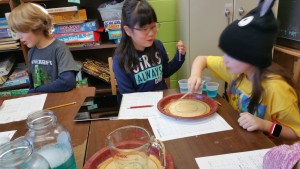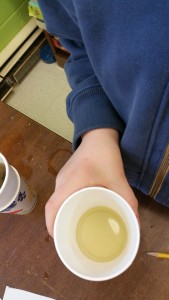We began our study of the water cycle by identifying where we can find water throughout the earth. An ocean evaporation demonstration helped us understand how the polar caps and glaciers are made of fresh water.
As we continued learning about evaporation, condensation, and precipitation, we had questions about a single water drop. That led to us learning about water molecules and performing experiments to learn about surface tension.
We had several activities that focused on the complete water cycle. We each created a mini water cycle in a closed baggie. Over several days we observed the liquid water evaporate from the cup, condense on the baggie, and precipitate, dripping down and collecting on the bottom of the baggie. We observed in the end that we still had the same amount of water that we started with. We demonstrated the water cycle using the heat from a burner to represent the sun’s heat and ice on a pan to represent cooler air in the upper atmosphere, watching water from a teakettle evaporate, condense on the bottom of the cold pan, precipitate in droplets, and then collect in a puddle on the table. Each student made an illustrated model of the water cycle.
We explored where the water we use in our day-to-day lives comes from. We learned which lakes CNY communities get their water from, how it is tested and filtered, and how it gets from the lakes to our homes. We simulated water treatment using alum, gravel, and sand. Although our water appeared much cleaner after treatment, we did not drink it!
Each student wrote a story telling the journey of a drop of water. They followed it as it moved to different places and changed form from liquid, gas, or solid, as it was heated or cooled.
Notable among the books we read to clarify our understanding of the water cycle and related concepts were Did a Dinosaur Drink This Water? by Robert E. Wells, The Snowflake: A Water Cycle Story, by Neil Waldman, and The Magic School Bus: At the Waterworks by Joanna Cole.
